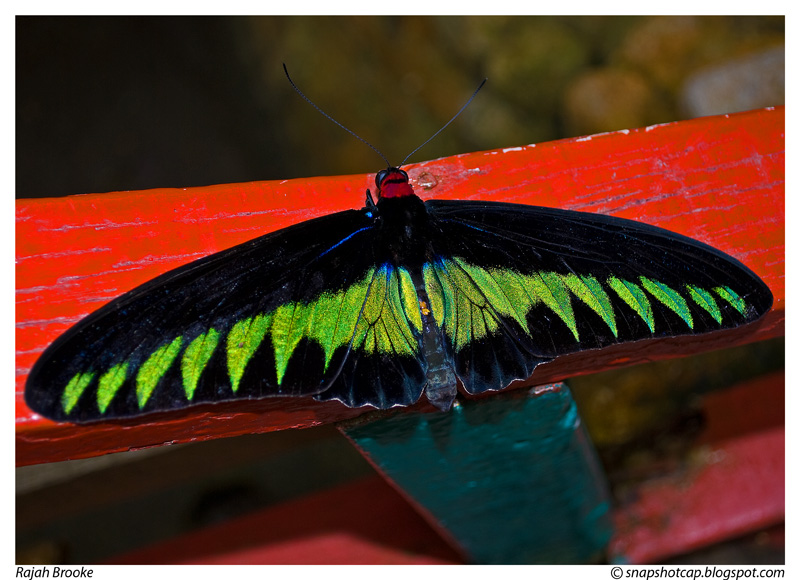There is only a little ruby or red color on Rajah Brooke's body and it is a red hollow triangular mark on its neck. Whereas, the wood where it landed indeed suitable for this Ruby Tuesday..lol.
Rajah Brooke’s Birdwing (Troides brookiana albescens) can rival the most beautiful species from other parts of the world, some says it's a King of Butterflies. This birdwing was discovered by famous British naturalist Alfred Russel Wallace during one of his expeditions to Borneo in 1855. He named it in honor of his friend Sir James Brooke, the Rajah of Sarawak.
Rajah Brooke is so easy to recognize. All the wings on the upperside were of a uniform jet-black color. On each forewing, with a wingspan about 15-17cm, which was extremely long than wide, there were altogether seven luminous green triangles, each with a faint black line bisecting it horizontally. Of the seven, the two triangles nearest the dorsum, or the horizontal part of the forewing, were joined. On each of the very much smaller hindwings the green pattern became a broad band near the wing bases, broken up only by the black veins that radiated from the wing cell.
Source: Malaysian Nature Society
Rajah Brooke’s Birdwing (Troides brookiana albescens) can rival the most beautiful species from other parts of the world, some says it's a King of Butterflies. This birdwing was discovered by famous British naturalist Alfred Russel Wallace during one of his expeditions to Borneo in 1855. He named it in honor of his friend Sir James Brooke, the Rajah of Sarawak.
Rajah Brooke is so easy to recognize. All the wings on the upperside were of a uniform jet-black color. On each forewing, with a wingspan about 15-17cm, which was extremely long than wide, there were altogether seven luminous green triangles, each with a faint black line bisecting it horizontally. Of the seven, the two triangles nearest the dorsum, or the horizontal part of the forewing, were joined. On each of the very much smaller hindwings the green pattern became a broad band near the wing bases, broken up only by the black veins that radiated from the wing cell.
Source: Malaysian Nature Society

YAY first! Good morning Bintang! I love this shade of green, beautiful picture! :):):)
ReplyDeleteGood morning Marzie..glad you like it :)
ReplyDeleteHapi:
ReplyDeleteThanks for the info, I almost forgot on how to change a favicon ;)
Wow, never seen one like it. Nice!
ReplyDeleteThat is so cool!!!
ReplyDeleteThat's beautiful! Like a miniature black airplane with green wings that has landed on a red airstrip. Kind of:)
ReplyDeleteI love Pia's comment! She described your photo perfectly
ReplyDeleteall I can add is stunning!
It is a beautiful picture, as usual ;-)
ReplyDeleteoh you're at my site now & I'm here! LOL!
ReplyDeleteThat is a unique butterfly, beautiful too.
ReplyDeleteHappy Wednesday! Bloghoppin' here... Hey, I have an interesting tutorial for you that I have written myself. It is about adding Adsense on your Single Post in XML template. I hope you'll like it! God Bless you!
ReplyDeleteA fantastic Birdwing butterfly; we have a similar one the Richmond Birdwing Butterfly. It is very rare needs a special vine to lay its eggs.( I was wondering about the numbers on the neck of the horse too; that was the first thing I thought about. I have to make an inquiry how it is done. In Switzerland they have generally strong rules about treating animals. Per example it is not allowed to keep hens in batteries anymore. Which I think is a very good thing too.
ReplyDelete